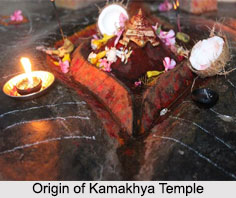 As per the Kalika Purana, there have been mentions of the Kamakhya Devi, who is a Tantric goddess of worship. The Kamakhya Temple is one of the 51 Shakti Peethas situated on the Nilachal Hills in the western part of the city of Guwahati in the state of Assam.
As per the Kalika Purana, there have been mentions of the Kamakhya Devi, who is a Tantric goddess of worship. The Kamakhya Temple is one of the 51 Shakti Peethas situated on the Nilachal Hills in the western part of the city of Guwahati in the state of Assam.
Historical Origin of Kamakhya Temple
Archaeological excavations has revealed that the origin of Kamakhya temple dates back to the 9th century Kamarupa inscriptions on Tezpur plates , where there are mentions of Kamakhya Devi and a temple. In the 10th century, the Kalika Purana was composed and Kamakhya soon became a renowned centre of Tantric sacrifices, mysticism and sorcery.
In the medieval era, it is said that the temple was destroyed by Hussein Shah"s invasion of the Kamata kingdom. Later, the ruins of the temple were discovered by Vishwa Singha, the founder of the Kochi dynasty, who revived worship at the site. Over the centuries, the Kamakhya temple has been under the reign of various rulers, with the last ruler being the eldest son of Siba Singha, who became the king, and delegated the management of the Kamakhya temple to Mahant Krishnaram Bhattacharyya. The Mahant and his successors came to be known as Parbatiya Gosains, as they resided on top of the Nilachal hill. Many Kamakhya priests and modern Saktas of Assam are either disciples or descendants of the Parbatiya Gosains.
Symbolic Origin of Kamakhya Temple
The Kamakhya temple is the main temple in a complex of individual temples dedicated to the 10 Mahavidyas of Shaktism. This worship of all female deities symbolise the fusion of faiths and practises of the Aryan and non Aryan elements in Assam. The Kamakhya temple is one of the Shakti Peethas, where the genitals or "yoni" of Goddess Sati fell. Hence, it is said that the Guwahati area up to the Manas River formed the waist on the position of the genital organ and was known as the Kamapitha.
From a natural spring flowing out of a rocky hill on the bank of the Brahmaputra River oozed out reddish water due to the fact that the rock contained red Haematite. The water of this stream assumed a reddish tingle only during the rainy season when the flow increased naturally and in the other part of the year the colour was natural. At the point at which water oozed out from the rock, at its foot there was a natural fissure conical in shape about 9 inches in width and reddish pink in colour similar to that of a female"s genitals. This further strengthened the belief that Mother Earth menstruated through this fissure at the pick time of cultivation.
The place was therefore called "ka-mai-kha", which means mother water course. Later on the Hindus named the place Kamakhya and worshipped it as the genital organ of the Supreme Mother.
Legends behind the Origin of Kamakhya Temple
There are various myths and legends associated with the origin of Kamakhya temple. The first one is based on the Hindu mythology; the Nilachal Hills where Goddess Sati"s "yoni" fell represented the body of Lord Shiva and turned blue. It is here that the Kamakhya temple was constructed.
Another legend mentions Nara Narayana and his younger brother Cilaray, both of whom were separated from their army on a night of their military expedition. During this time they met an old lady on the Nilachal hillock, who was praying along the banks of a rivulet. To their enquiry she told them that anybody worshipping there gets his wishes fulfilled. Thus it is believed that it was referred to Goddess Kamakhaya.
Then there is the Kalika Purana, where it is stated that the place where Goddess Sati and Lord Shiva used to come together for their secret love tryst is the temple of Kamakhya. The Yogini Tantra also furnishes certain facts, and emphasises on the creative symbolism of the "yoni". It is said that the original temple was built by Kamadeva, who had been turned to ashes by Lord Shiva for disturbing his meditation but was later brought back to life after he promised to build a temple on the spot where Sati"s yoni had fallen.





















